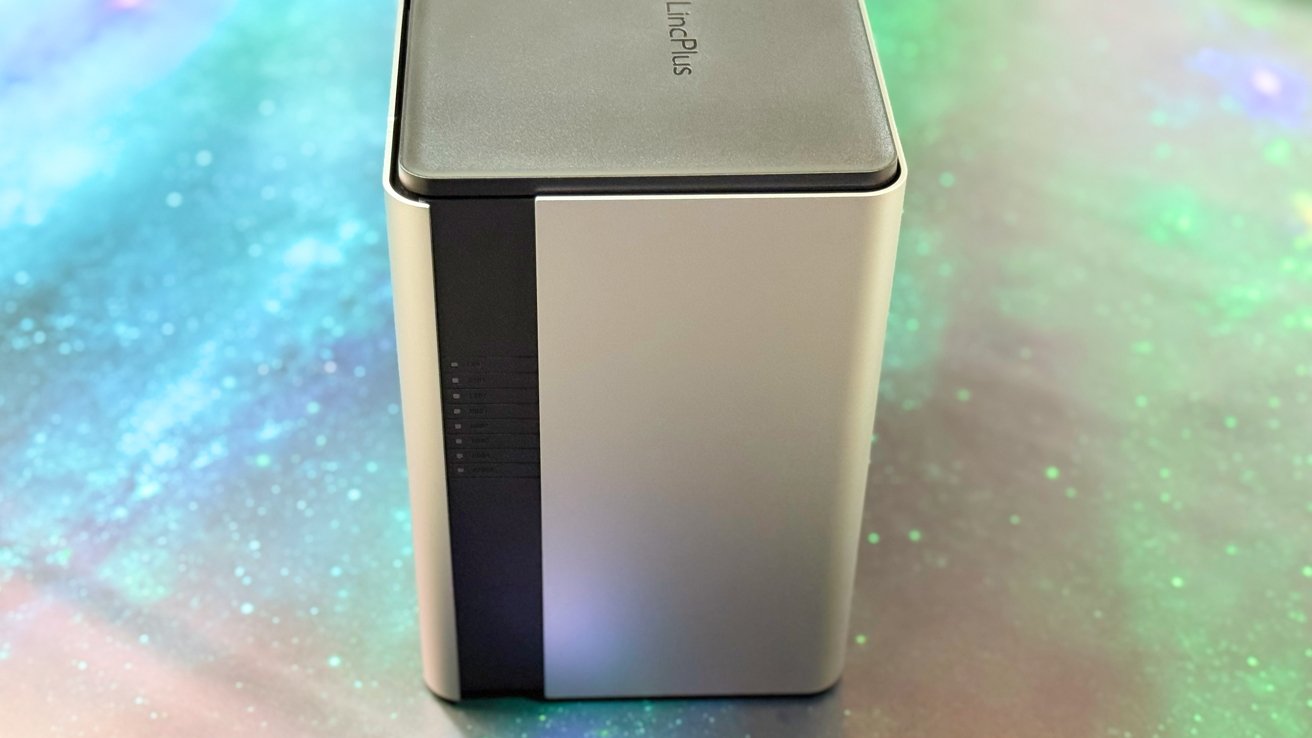The LincPlus LincStation S1 network-attached storage device balances speed and storage capacity pretty well, while also being stylish enough to not look out of place on an Apple-centric desktop.
Back in March, I reviewed the LincPlus LincStation N2. It was a network storage appliance that not only looked good, but also worked fast due to being an all-SSD device.
However, an SSD-centric NAS has some shortcomings when compared to network speed. You won’t fully take advantage of NVMe drives, and SSDs are far more expensive on a per-terabyte basis compared to spinning disks.
Spinning metal is still king when it comes to storage capacity in network accessible storage. You just don’t need SSD-only file repositories on the desktop for everything.
The LincPlus LincStation S1 follows a similar route to the N2, providing storage in a fairly attractive package.
But, crucially, it works with internal hard drives.
LincPlus LincStation S1 review: Physical design
A normal NAS is an anonymous box that lives in the corner, with no expectations of anyone looking at it except to switch drives or to perform some kind of maintenance. The LincStation S1 is a bit of a departure from that.
There’s no getting away from it being a box. They all hold drives of one sort or another. However, the silver and black appearance is quite a bit different from the usual NAS experience.
Part of this is because there is an expectation for it to be in view, as it can be hooked up to a TV. It therefore has to look reasonably good when put against other hardware, possibly stored in a person’s living room.
At 7.7 inches by 6.1 inches and 9.1 inches tall, it’s a box that is a little bit bigger than the four hard drives and other components that it holds. It’s not too big for a device of its kind, but at 6.4 pounds unladen, it’s not something you’re expecting to move that often.
The front panel includes a series of LEDs, as well as an LCD screen that offers some basic operation details. There’s also a USB-C 3.2 Gen 2 port and a USB Type-A 3.2 Gen 2 connection for quickly plugging in external storage or peripherals, and a power button.
Around the back are another USB-C and USB-A connection with USB 3.2 Gen 2 speed, along with two USB 2.0 Type-A ports. A HDMI 2.0 connection is available for connecting to an external display, making it handy for multimedia or for direct management of the NAS.
There is no way to directly connect the LincStation S1 directly to a computer with USB or Thunderbolt. These days, Drobo-like connectivity has mostly gone the way of the dodo, so this is not a strike against the hardware.
Two 2.5-gigabit Ethernet ports are also on the back.
In the base is a fan for cooling. In our testing, the fan is just barely noticeable even when hammering on the processor from four feet away with normal office noise.
LincPlus LincStation S1 review: Software setup and interface
While the styling is very consumer-forward, the software side of things is less so. This is chiefly due to the use of UnRAID, which isn’t exactly consumer-friendly.
UnRAID is a very robust NAS platform, and a license comes with the hardware. It is capable of running virtual machines and using Docker containers.
LincPlus includes an UnRAID license with the NAS, but it lasts for one year. After that, if you want OS updates, you have to pay from $49 and up per year.
What UnRAID does give you is a wide number of features, including storage management, backups, file synchronization, surveillance, a multimedia center, and server functionality. If you want, you can take advantage of Docker to do things like run Plex, if you want the NAS to become a media server for your home.
This is a lot for a NAS to do, though not really straying outside the bounds of expectation for such a device.
Your drives are able to be set up in RAID 0, 1, 5, 6, and 10. You could also set up cache pools if you want to be more efficient with your storage.
LincPlus LincStation S1 review: Drives and processing
The top cover, bearing the company name, pops off and serves as the access point for the four hard disk bays. It supports both 2.5-inch and 3.5-inch hard drives and SSDs using SATA 3.0.
LincPlus uses a set of tool-free drive sleds, which can each be pulled out from the top.
A side cover can be pulled off to reveal a pair of M.2 NVMe slots, which work with M.2 2280 sticks. Each also has a heatsink, which helps keep the drives cool while under load.
This space is also where the memory is located. There’s an included 8GB stick of DDR5 memory in a single SODIMM, which can be replaced and upgraded by the user, if need be.
You probably want to upgrade this if you’re using Docker. In our review, things got a little constrained when hosting virtual machines.
I tested it with Plex and a few add-on packages like Radarr and Sonarr. Plex itself streamed fine while transcoding to four clients simultaneously. This dropped to three after the addition of Radarr and Sonarr.
I didn’t know if it was RAM or processing that caused the decrease in transcoding capacity when I reviewed the LincStation N2. The processor in the S1 is beefier than that in the N2, but RAM appears to be the constraining factor.
Get 16GB of RAM. You won’t be sorry.
Rounding out the storage is a built-in 128GB eMMC unit. This is used for the operating system, rather than something that’s user accessible.
Overall, it can support up to 112 terabytes across the four 3.5-inch SATA bays and the two NVMe slots. The obvious benefit is that both storage types can be used independently, with large projects stored on the hard disks, but the more speed-sensitive or regularly accessed data being available on the faster drives.
Processing is handled by an Intel Alder Lake N97 processor, which is a quad-core chip with four threads and a 3.6GHz maximum clock speed. More importantly, it has a 12-watt thermal design point, so it will run cool enough for the NAS not to heat up too much.
Network access is handled through the two 2.5-gigabit Ethernet ports, which can be combined with some routers using link aggregation to work at up to 5 gigabits.
Regardless of which OS you choose, networking performance is adequate, and about what the company promises. With two SSDs and four hard drives, you can get to about 70% of your 10-gig network speeds, mostly because of PCI-E lane limitations and networking overhead. This is more than enough for the target market, and you’ll easily saturate a 2.5-gig or gigabit network.
Given the potential storage capacity and SSD storage, it is a shame that there isn’t the possibility to use 10-gigabit Ethernet for the files on the NVMe drives, either as a single port or in combination. It’s clear that this was omitted to keep the price point down, but it’s a strike against it for a lack of futureproofing.
As before, networks that support 10-gigabit speeds are few and far between — and expensive. There’s no way to expand the NAS with PCI-E cards, so the S1, like the D2, sits in a strange limbo between high-performance enterprise storage solutions and SOHO ones.
This does not matter one bit for files stored on the spinning drives, though.
We hit a peak of 66 watts of power consumed when hammering on the enclosure with Plex transcoding in Docker, and doing a big file transfer. Idle, it sits at about 32W with the drives sleeping.
LincPlus LincStation S1 review: More storage options, but still room for improvement
The LincStation S1 is a fairly typical example of a modern NAS. It’s capable of holding a bunch of high-capacity spinning metal drives, and offsets the slowness with NVMe speeds.
This is theoretically the best of both worlds.
However, while it can boast fast transfers thanks to the solid-state storage elements, the lack of 10-gig Ethernet is a disappointment. The lack of any real upgradability for this element is also a bit of an issue.
UnRAID may not necessarily be every home user’s choice for an operating system, especially beyond the one-year license period. But it’s still flexible enough to do an awful lot for the more demanding user.
Then there’s the appearance, which is based on expectations that it will be visible instead of hidden away in a networking closet.
LincPlus has done a lot to balance capacity and speed, while making a very capable NAS that wouldn’t look out of place next to a TV in the living room.
There are some small quibbles with the hardware, but overall, it does quite well.
LincPlus LincStation S1 review: Pros
- Sleek appearance
- Mixes hard disks with speedy NVMe
- Flexibility of UnRAID, and a one-year support license is in the box, but…
LincPlus LincStation S1 review: Cons
- UnRAID support is an annual $50 license
- No 10-gig Ethernet, but fortunately, that’s not that necessary yet
- Really needs 16GB or more RAM for Docker, but only comes with 8GB
Rating: 4 out of 5
Where to buy the LincPlus LincStation S1
The LincPlus LincStation S1 is available from LincPlus directly, priced at $599









